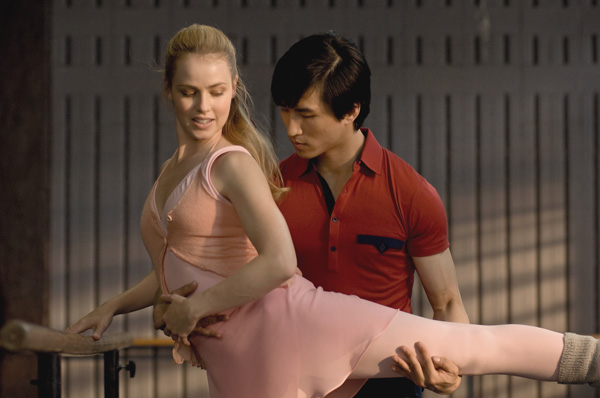|
Reviews of Recent Independent, Foreign, & Documentary Films in Theaters and DVD/Home Video

MAO’S
LAST DANCER The story of Li Cunxin is inspirational, no doubt. Literally plucked from his rural school desk at a young age to attend the Beijing Dance Academy, he went on to a career in America, becoming a star at the Houston Ballet. But nearly everything you'd think would go into a standard rags-to-riches biopic is in Mao’s Last Dancer, nearly two hours’ worth of visual and verbal platitudes substituting for substance. Bruce Beresford is a hard-working filmmaker who has made several good and a handful of excellent films in his native Australia and America, including Breaker Morant, Don’s Party, and Tender Mercies. In his defense, it’s nearly unavoidable in a movie like this not to bump into clichés at every turn. Based on Li’s autobiography of the same name, Mao’s Last Dancer begins in 1981 at the Houston airport—we’re in Reagan’s America, none-too-subtly shown by a framed portrait of the new president, which greets Li at the airport. After his introduction to Houston Ballet artistic director Ben Stevenson, Li is off on a whirlwind tour of American skyscrapers, malls, fancy clothes, and bad disco music. Flashbacks return us to Li’s hometown in a remote part of China, and we see a youngster with little contact with the outside world. He’s selected as a dancer purely by chance—government officials come to his school but decide not to choose any children in his class until his teacher asks them to reconsider Li. Soon he’s in Beijing partaking in grueling practice sessions. The movie shuttles between Li’s childhood and early schooling in dance to his early difficulties and later triumphs in the United States, including his decision to defect and marry his American sweetheart (and fellow dancer) Elizabeth instead of returning to China. There’s nothing particularly egregious about the missteps of Mao’s Last Dancer. It’s competently made, well-photographed, and shows a backstage view of ballet rarely seen onscreen outside of documentaries and Robert Altman’s The Company. But its surface treatment of events in Li’s life smack of the Lifetime Channel and daytime soap operas. From the start, Beresford overdoes Li’s amazement when he first comes to America, with too many shots of him staring wide-eyed as he sees yet another monument to capitalism. When Li enters Ben’s house for the first time, he asks, “Ben, you have a big family?” to which Ben nonchalantly responds, “No, it’s just me.” Similarly, Li is told by the head of the Chinese Embassy not to fall for the evils of America, especially the women—which Li promptly does. It’s not that this didn’t happen to Li, it’s that it’s all presented in such an eye-rolling, cutesy way. With assistance from choreographers Graeme Murphy and Janet Vernon, Beresford does well with the ballet sequences, especially the adult Li’s triumphant appearance in The Rite of Spring, after which he has an emotional reunion with the parents he hasn’t seen since he was taken away to Beijing. (This scene is by far the most touching in the entire film.) Even here, however, there’s cheating. Li actually danced in The Nutcracker when his parents came to Houston, but since that’s a family-oriented ballet, it was changed to Stravinsky’s erotic classic so that his parents can be shocked at their nearly-nude dancing son. Isn’t it enough that they’re surprised to see him onstage at all? Another reason Mao’s Last Dancer comes up short is the painfully uneven acting. Beresford has mentioned how he and producer Jane Scott scoured the world for a Chinese dancer who could speak English and Mandarin and know how to act until they went to the ballet in Sunderland, England, and found Chi Cao. He surely dances terrifically and speaks English clearly (if with a slight British accent that's strange for someone who never traveled outside China before coming to America), but he’s a stiff actor with very little range. Although this works somewhat for the early sequences of a scared, inhibited young man in America, it palls fast.
Unfortunately, another non-acting dancer,
Amanda Schull, plays Elizabeth, and their scenes together are the least
effective in the film, particularly a cringe-inducing argument that
plays out like amateur hour at the local dinner theater. Conversely, Bruce
Greenwood shrilly overacts as Ben, perhaps to compensate for Chi Cao’s
blankness. Best are Joan Chen’s powerful presence as Li’s mother and the
always-reliable Jack Thompson—who starred in Beresford’s classic
Breaker Morant—as the Texas judge who grants an injunction when the
Chinese Embassy kidnaps Li in an attempt to return him to his home. When
these two veteran performers are briefly onscreen, Mao’s Last Dancer
hints at the heartwarming but gritty true story it wants to be.
Kevin Filipski
|

